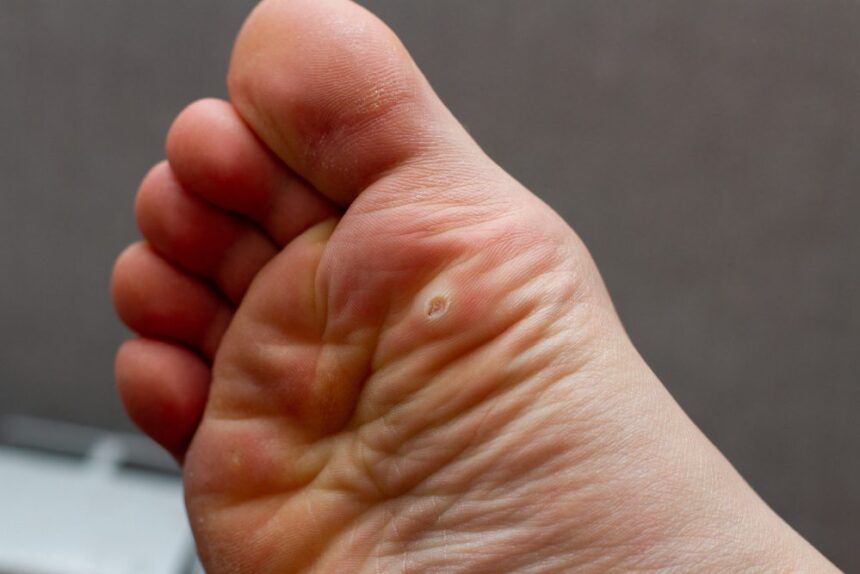Plantar warts are common and cause discomfort and pain on the soles of the feet. These growths can interfere with daily activities, such as walking, running, or standing for extended periods. Understanding these warts, their causes, symptoms, and available treatments can help you make informed decisions about managing this foot condition.
What Are Plantar Warts?
Plantar warts are benign skin growths that develop on the weight-bearing surfaces of the feet, particularly the heels and balls of the feet. These warts grow inward due to the pressure exerted when walking or standing, creating a thick, callus-like appearance. Unlike other types of warts that protrude from the skin surface, these warts remain relatively flat due to constant pressure from body weight.
The growths typically appear as small, fleshy lesions with a rough, grainy texture. They often contain small black dots, which are small clotted blood vessels. Plantar warts can occur as single lesions or in clusters, with mosaic warts being the term used to describe multiple warts grouped in one area.
What Causes Them?
The human papillomavirus (HPV) is the cause of this condition. This virus enters the skin through small cuts, breaks, or weak spots on the bottom of the feet. The virus thrives in warm, moist environments, making public pools, locker rooms, and communal showers common sites for transmission.
Direct contact with contaminated surfaces or infected individuals can spread the virus. The incubation period varies, with warts potentially appearing weeks to months after initial exposure. Individuals with compromised immune systems, as well as children and teenagers, face a higher risk of developing plantar warts due to their unique immune response characteristics. Factors that increase susceptibility include walking barefoot in public areas, sharing personal items such as towels or shoes, and having pre-existing foot injuries.
What Are the Symptoms?
Plantar warts are a common foot condition characterized by unique symptoms that distinguish them from other foot issues. They often cause pain, especially during weight-bearing activities, and have a distinctive appearance that can make them easy to identify. Symptoms may include:
- Sharp or burning pain when walking, standing, or applying pressure
- Hardened, thickened skin with a rough texture
- Small black pinpoints (thrombosed capillaries) visible within the wart
- Raised or callused surrounding skin, disrupting the foot’s natural lines
- Tenderness when squeezed from the sides
- Discomfort when wearing specific shoes
- Possible bleeding if scraped or cut
These symptoms can make everyday activities uncomfortable, so identifying and addressing this condition promptly is integral for relief.
What Are the Treatment Options?
Several treatment approaches exist for plantar warts, ranging from topical applications to surgical procedures. Bako verrustat liquid wart remover offers a targeted topical treatment formulated explicitly for this condition. This solution works by breaking down the infected tissue while preserving surrounding healthy skin. Prescription-strength salicylic acid works by gradually dissolving the wart tissue through keratolytic action.
Compound wart medications combine multiple active ingredients to enhance treatment effectiveness. Cryotherapy involves applying liquid nitrogen to freeze and destroy the tissue of warts. This treatment creates a controlled frostbite effect that eliminates infected cells.
Surgical removal becomes necessary when conservative treatments fail to resolve the condition. Procedures may include excision under local anesthesia. Consulting a podiatrist helps determine which treatment is suitable for each situation.
Speak to a Podiatrist Today
Plantar warts can impact your daily comfort and mobility if left untreated. Understanding the various treatment options available allows you to make informed decisions about managing your condition effectively. Contact a qualified podiatrist to discuss your symptoms and explore the treatment options that suit your needs and lifestyle.









